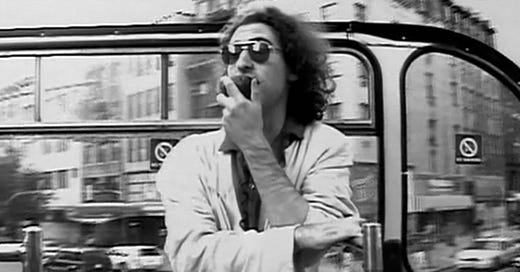Timothy Levitch is a couchsurfing New Yorker who earned himself a cult following in the ’90s thanks to the eccentric monologues he delivered while perched atop the double-decker buses of Gray Line Tours. What elevates his shtick from the pabulum of common tourguides is that he continuously dances with, wages war with, falls in love with Manhattan—it isn’t merely a series of stops and sights for him, it’s alive and worthy of philosophy. The Empire State Building is the catharsis of phallic emotion. Central Park is for transcendentalists, not runners. Dylan Thomas drank himself to death here.
Levitch plods around duckfooted like Chaplin’s Little Tramp, but don’t let that fool you—he’s acutely aware of the camera, and paints his portrait of New York City in the shadow of his own gigantic self-portrait. The balustrades of Brooklyn Bridge exist to console him, the terra cotta facade of Alwyn Court exists to arouse him, the Twin Towers exist to dizzy him. He’s a virtuoso narcissist, not a mediocre one, like the private enemies he publicly—and extravagantly—berates.
Central to Levitch’s philosophy is the idea of cruising, which is about being, like Baudelaire’s flâneur, a “passionate spectator, [for whom] it is an immense joy to set up house in the heart of the multitude, amid the ebb and flow of movement, in the midst of the fugitive and the infinite.” Cruising is about searching, however fleetingly, for beauty and individuality; about leisure and opposing full-time employment; about getting laid. At one point, Levitch rails against the ugly uniform he’s made to wear because it will, by making him look like the other tourguides, tank his romantic prospects. The enforcers of conformity—policemen, managers, and elderly relatives—constitute the anti-cruise, which Levitch has been evading for most of his life.
As I watched Levitch amble and ramble around the city, I lamented the decline of Bohemia and the near-complete takeover of corporate blandness and efficiency. Like with Manhattan’s gridded streets, few will remember that there were once meandering lanes. It isn’t only Greenwich Village that now houses minor royalty rather than struggling artists; even here in Bloomington, affordable flats are being swallowed up by behemoth real estate companies and local shops are being replaced by an endless series of chains. Everywhere looks like everywhere else. The counterculture is on life support. The anti-cruise is closing in.




